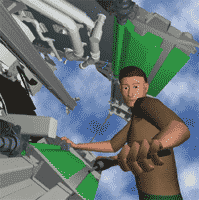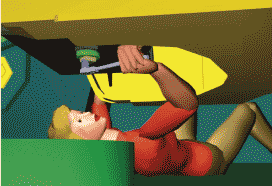
Jack of All Trades
 If you don’t know jack about hybrid inertial-acoustic tracking technology, then
you probably have not been introduced to
Tecnomatix Jack, a human modeling and
simulation tool from Siemens PLM Software.
Designed to improve the ergonomics
of product designs and workplace tasks in
virtually any environment, the software
features the titular humanoid Jack and his
digital cohort, Jill. Both are biomechanically
accurate avatars that can be scaled by
stature and weight and placed in simulated
work settings for quantitative feedback on
injury risk, strength capability, posture
analysis, fatigue, and task timing.
If you don’t know jack about hybrid inertial-acoustic tracking technology, then
you probably have not been introduced to
Tecnomatix Jack, a human modeling and
simulation tool from Siemens PLM Software.
Designed to improve the ergonomics
of product designs and workplace tasks in
virtually any environment, the software
features the titular humanoid Jack and his
digital cohort, Jill. Both are biomechanically
accurate avatars that can be scaled by
stature and weight and placed in simulated
work settings for quantitative feedback on
injury risk, strength capability, posture
analysis, fatigue, and task timing.
Jack and Jill provide this ergonomic
feedback—telling engineers, for example,
what they can see and reach, how comfortable
they are, when and why they are getting
hurt, when they are getting tired, and
so on—through the software’s incorporation
of advanced empirical models, inverse
kinematics, and body dimension measurements
taken from several anthropometric
databases. These parameters can be further
enhanced by a Jack add-on Task Analysis
Toolkit loaded with more predictive tools
for analyzing such human factors issues as
low-back spinal force, lifting, and metabolic
energy expenditure, among others.
What this all means in layman’s terms,
according to Dean Wormell, director of
visualization and simulation applications
marketing for InterSense Inc., the Bedford,
Mass.-based company that provides the
motion-tracking system for the latest version
of the software, is that digital humans
can go (or be placed) in an exact replica of
a workplace, perform assigned tasks, and
find any problem early in the design stage,
before hazards become difficult and costly
to correct.
Jack the Gripper
“It’s a program that allows you to measure
and monitor human performance,”
Wormell says. “Say someone does a
repetitive motion 100 times on a joint.
The model might say, for example, that if
they move their arm 300 times that way
they would be maybe only 50 or 60 percent
as efficient as when they started.
Those types of parameters are built in,
and you can make measurements on
them,” using the calculations to refine
tasks, correct design flaws, and build
more ergonomically sound products in
safer, more productive environments.
Rendering a person’s real-world movements
accurately in the virtual world is a
crucial part of using digital humans to
make such measurements. To be useful—
and not give the user motion sickness—the
orientation has to be precise as the realtime
movements are translated into data,
which the predictive software then uses for
calculating such factors as grip force,
torque, and general performance in the
space of the virtual environment. This is
where the hybrid inertial-acoustic tracking
technology comes in.
Developed by InterSense as a plug-in
for the Jack program, the hybrid technology
is a fusion of various motiontracking
systems designed to overcome the
limitations inherent to any one tracking
device when used alone. Wormell describes
InterSense’s multi-sensing technology as a
microelectromechanical system that integrates
gyroscopes, accelerometers, and
magnetometers into sensors on an acoustic
grid that functions “like a little local GPS
system, with the acoustic emitters being
satellites, essentially.”
Jack Formation
From its earliest days, the Jack software has
always used some type of motion-tracking
system. First licensed and released in 1997
as “Transom Jack” and later called “Visualization
Jack,” the software became part of
the UGS Tecnomatix family in April 2005.
When the automation giant Siemens
acquired UGS in early 2007 for $3.5 billion,
Jack and Jill became part of the company’s
PLM (Product Lifecycle Management)
Software division. The first Jack
release to include an InterSense interface,
one of several motion-tracking systems
available to Jack users, was version 5.1 of
the software, released in July 2006. Each
Jack generation has become more realistic,
precise, and analytically useful, even as the
technology behind it has improved.
“Now that we have the ability to visualize
and virtualize the working environment,
we can use tools like Jack more productively
without having to worry about
keeping a network or supercomputer running
in the back room,” Wormell says. “As
computer power and graphic horsepower
has increased over the past several years, it’s
gotten to the point where a lot of these
tools can be run on more standard platforms,
making them more accessible to
more people.”
The recommended hardware platforms
for Jack include Windows 2000/XP,
Hewlett-Packard HPUX v.11, and Silicon
Graphics IRIX 6.5x.
This article originally appeared in the December 2007 issue of Occupational Health & Safety.